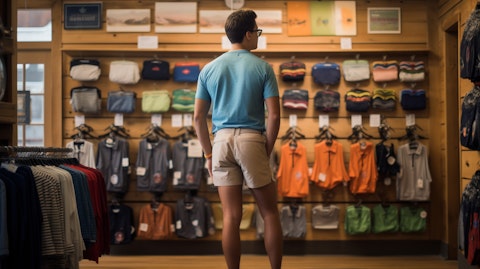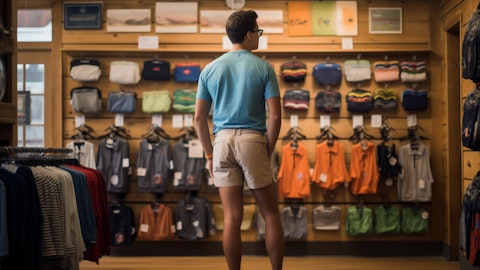Solo Brands, Inc. (NYSE:DTC) Q4 2023 Earnings Call Transcript March 14, 2024
Solo Brands, Inc. misses on earnings expectations. Reported EPS is $0.13 EPS, expectations were $0.14. DTC isn’t one of the 30 most popular stocks among hedge funds at the end of the third quarter (see the details here).
Operator: Hello everyone and welcome to Solo Brands Incorporated Fourth Quarter and Fiscal 2023 Financial Results. My name is Emily and I’ll be facilitating your call today. [Operator Instructions] I will now turn the call over to our host, Bruce Williams, Managing Director at ICR. Please go ahead, Bruce.
Bruce Williams: Good morning, everyone, and thank you for joining the call to discuss Solo Brand’s fourth quarter results, which we released this morning and can be found on the Investor Relations section of our website at investors.solobrands.com. Today’s call will be hosted by Chief Executive Officer, Chris Metz, and Chief Financial Officer, Laura Coffey. Before we get started, I want to remind everyone that management’s remarks on this call may contain forward-looking statements within the meaning of the Private Security Litigation Reform Act of 1995 that are based on current management expectations. These may include without limitation, predictions, expectations, targets, or estimates, including regarding our anticipated financial performance, business plans, and objectives.
Future events and developments and actual results could differ materially from those mentioned. These forward-looking statements also involve substantial risks and uncertainties, some of which may be outside of our control, and that could cause actual results to differ materially from those expressed or implied by such statements. These risks and uncertainties, among others, are discussed in our filings with the SEC. We encourage you to review these filings for a discussion of these risks, including our soon-to-be-filed annual report on Form 10-K, and will be available on the Investors portion of our website at investors.solobrands.com. You should not place undue reliance on these forward-looking statements. These statements are made only as of today and we undertake no obligation to update or revise them for any new information except as required by law.
This call will also contain certain non-GAAP financial measures including net income as adjusted, diluted earnings per share as adjusted, gross margin as adjusted, adjusted EBITDA and adjusted EBITDA margin, which we believe are useful supplemental measures that assist in evaluating our ability to generate earnings, provide consistency and comparability with our past performance, and facilitate period-to-period comparisons of our core operating results and the results of peer companies. Reconciliation of these non-GAAP measures to the most comparable GAAP measures and definitions of these indicators are included in our earnings release, which will be available to our investors portion of our website at investors.solobrands.com. Now I’d like to turn the call over to Chris.
Chris Metz: Thank you for joining us today. I am very excited to be the new CEO of Solo Brands, and I couldn’t think of a better time to join the company. My first 60 days in has only confirmed my belief in the upside and opportunities that lie ahead of us. Many of you may be thinking, what attracted me to the role, and why was I the right choice for the role. First, let me share a bit about my background. Early in my career, I joined one of the world’s premier consumer durable goods companies in Black & Decker. Over the next 13 years, I rose from Assistant Product Manager to President. During that time, I was also part of a team that launched DEWALT power tools, giving me the opportunity to lead the European professional power tools group based in Germany.
Black & Decker was my training ground for how to develop innovative products, compelling marketing campaigns, and build aspirational brands. From there, I spent a decade in private equity, honing my leadership skills in many different consumer branded companies for a leading PE firm. I then spent time as CEO of public company Arctic Cat, building an iconic power sports brand and selling it to a Fortune 500 company. And most recently, I was CEO of public company Vista Outdoor, a multi-billion dollar collection of 41 leading consumer durables brands. During my tenure at Vista, we nearly doubled sales and drove incredible returns for shareholders. I was attracted to Solo Brands because of my passion for the outdoors, the strength of the core brands, and the loyal following consumers have for the brands and products.
However, frankly speaking, some areas need to be strengthened. I believe there is enormous upside at a company that generates high margins and strong free cash flow with low leverage. I believe the company provides a strong platform for growth and is a perfect fit with my past experiences of leading multi-branded public companies. Developing the right strategies, attracting a talented team, and instilling a performance-based culture that executes relentlessly is what I enjoy and where I excel. In the two months since I joined Solo Brands, I’ve spent my time diving into the business, meeting our teams, assessing our brands, and understanding our strengths and opportunities. Today, I will share my initial observations and thoughts on areas of focus and the actions we are taking.
However, before I jump into this, I would like to introduce our new Chief Financial Officer, Laura Coffey. I couldn’t be more excited to have Laura as a partner. She has extensive financial experience working with public companies and has worked in consumer-centered companies most of her career. We’re excited to welcome her to the team. After my prepared remarks, I will turn the call over to Laura to take you through our financials and provide our initial outlook for fiscal 2024. Our brands were founded by entrepreneurs, whose creativity and drive to innovate and disrupt created entirely new categories and opportunities. I see tremendous potential in our brands, which is supported by the company’s strong financial position. However, I recognize that there is work to be done to fix our issues and improve the performance of our company.
I will frame this up at a high level in terms of what we need to return to growth. First, we need to develop and execute against a well-defined company strategic plan, a plan that allows us to double down on our core businesses, Solo Stove and Chubbies. Secondly, we need to fix our D2C or direct-to-consumer business and return this channel to growth. Third, we need to develop a more comprehensive omni-channel strategy that will not be dilutive to our overall EBITDA margins. Fourth, we need to develop an innovative product pipeline for our core Solo Stove business and identify near adjacencies that will expand our TAM. And fifth, we need to recruit a talented leadership team, a team that has what I call, been there, done that, experience, a leadership team with a proven track record for both results and attracting other talented people to strengthen our team.
These high-level issues we need to address are my initial observations. However, we need to and will dig deeper. In fact, we are currently undergoing a full strategic review of every key facet of our company and have engaged a leading strategic firm to help us in this work. I’ve been in the seat for 60 days, and although I may not have all the answers to questions you may have today, I will in time as we formulate our strategic priorities. Let me now speak more specifically to our two largest and critical brands and where much of my focus will be. Turning to Solo Stove, I have complete admiration for what the founders and team have built at Solo Stove. However, like many entrepreneur founded businesses, the appropriate processes and capabilities necessary to scale the business have not been built out.
From my initial observations, everything I have seen can be fixed. As I mentioned, we are currently undergoing a full strategic review that will result in a clear long-term plan. As part of this, we are conducting a deep assessment of our consumers and these insights will lead to a better understanding of TAMs, profit pools, and channels where our products are purchased. These insights will also inform our product roadmap, our brand strategy, and how best to utilize our marketing dollars. In parallel with doing this strategic work, we are focused on three key priorities, revenue growth, product innovation, and talent acquisition. Within our top priority, revenue growth, our first immediate focus area is the need to address the decline in sales of our Solo Stove business.
We have high gross margins, but we are not spending our marketing dollars effectively, and therefore, we are not achieving the return on ad spend or ROAS we expect to help drive our growth. To that end, in the past 30 days, we have hired a new Chief Growth Officer and a new leader of brand marketing and consumer insights to address this issue. We have also taken immediate action to restructure our marketing partnerships. First, we are ending our marketing contract with an outside firm that has placed much of our media spend. Second, we are also replacing our current marketing agency. We have moved our business to a new marketing agency that has strong full funnel performance and digital marketing capabilities. Our new partner has deep experience working with D2C firms that also have an omnichannel footprint, such as Nike, Athleta, Kohler, Beats by Dre, and TheraBody.
We are excited about the potential to partner with a leading firm to assist us with our marketing strategies. Importantly, though, we’ve also started to upgrade our internal marketing team, so that we can develop more of these capabilities in-house to augment our partnerships with outside agencies. Another critical area of focus for us will be developing a more cohesive product innovation pipeline. We’ll be hiring a new leader of product development, and we’ll begin building a compelling three to five year product roadmap that will enable us to bring newness to our core category while also expanding upon our core. All of our new products will be developed with our key channel partners in mind, and we’ll have an integrated go-to-market plan that will optimize our product launches.

More to come on this in the future. Our third area of focus is building out the talent and capabilities within Solo Stove. We are fortunate to have a highly enthusiastic and energized team within Solo. However, we need to augment this team in key areas with deeper experience and skill sets. I previously mentioned the recent hiring of a Chief Growth Officer and the leader of brand marketing and consumer insights for Solo Stove. We have also recently added a Chief People Officer to help us across all of our brands as we continue to upgrade our talent. All of these investments are built into our guidance and will be factored into our strategic plan. I’m very excited and confident that we will get Solo Stove back to its winning ways. I acknowledge it will take some time, but I haven’t seen anything yet that leads me to believe we can’t win in a big way.
Turning now to our Chubbies business. Chubbies is coming off one of its best years in history in 2023 and starting the new year with strong momentum. It is one of the most exciting up and coming apparel brands in America today, with a very focused business plan and continues to execute at a high level. Chubbies’ core customer is the young male and the business has a balanced channel strategy of direct and wholesale with an emerging retail owned footprint. I do believe we can create tremendous value by supporting these two great brands and allowing them to grow in distinct ways. Personally, I have a lot of experience in multi-brand platforms and creating the culture that allows entrepreneurial high-growth brands like Solo Stove and Chubbies to flourish.
We believe that both Solo Stove and Chubbies are still relatively early in their growth cycles and have significant room to grow, both through direct and retail channels. We know we need to improve the performance of our Solo Stove direct business. However, as I mentioned previously, we will continue to meet our consumer where they shop through a balanced omni-channel distribution strategy. As part of our strategic work, we will confirm the TAM and the full potential for each channel of distribution without diluting profitability. In closing, I’m incredibly excited to be here leading this company and believe we have tremendous upside in front of us. In my early days, I have been impressed by the strength of our core brands, Solo Stove and Chubbies.
These are great businesses that have an entrepreneurial spirit with tremendous followings and are loved by our customers. However, I do recognize that there’s a lot of work to be done and it will take some time. We’re working to build the infrastructure in terms of people, capabilities, and processes to lay the foundation for us to deliver consistent growth over the long term. Now I’ll turn the call over to Laura.
Laura Coffey: Thank you, Chris, and good morning everyone. Let me start by saying I’m thrilled to be a part of the team here at Solo Brands with Chris. I was initially drawn to the company because of its unique digital-first business model. But in my short time with the company, I quickly came to understand why its customers have such incredible excitement and passion for these brands. Once I learned about the Solo story, I knew I wanted to be a part of the next phase of the company’s growth. Today, I will discuss our fourth quarter results and provide our outlook for fiscal 2024. For the quarter, sales were $165.3 million, a 16.2% decline compared to a year ago. The decline in sales was due to the weakness in our direct-to-consumer channel that was partially offset by growth in wholesale.
For the year, sales were $494.8 million compared to $517.6 million. In the direct channel, revenues declined 20.8% to $127.3 million in the fourth quarter, compared to $160.8 million a year ago, due to the lack of significant new product launches compared to the prior year. Total orders declined 28.6% and AOB increased marginally at 1%. For the year, direct channel revenues declined 15.4% to $358.1 million compared to $423.4 million. The decline was attributable to decreases in average order value and total orders of 8.1% and 12.4% respectively. Wholesale revenues increased 4.2% to $38 million compared to $36.5 million, driven by continued growth with our strategic partners. We are pleased to see the year-over-year growth as we are lapping 196% growth in the comparable period.
For the full year, wholesale revenues were $136.7 million compared to $94.2 million in the prior year and grew 45.1%. Turning to gross margin, fourth quarter gross margin decreased 150 basis points to 58.3% due to a channel mix shift partially offset by lower freight cost. Adjusted gross margin declined 90 basis points to 58.9%. For the year, gross margins declined 40 basis points to 61.1% compared to 61.5% and reflect the purchase accounting adjustments related to acquired businesses along with the channel mix shift from direct to customer to wholesale. Adjusted gross margins declined 170 basis points to 61.3%, which relates to the channel mix shift. Selling, general and administrative expenses for the quarter decreased to $80 million compared to $84.7 million a year ago.
The decrease was due to lower fixed costs related mostly to reduction in performance-based bonuses, partially offset by a $1.9 million increase in variable costs. As a percentage of sales, SG&A expense increased to 48.4% of sales compared to 43% a year ago due primarily to increased advertising and marketing costs during the quarter. For the year, SG&A was $249.4 million compared to $259.1 million. The decrease in SG&A was due to lower shipping and distribution costs, partially offset by higher advertising and marketing expense. As a percentage of sales, SG&A increased 40 basis points to 50.4%. We recorded an impairment charge of $249 million during the quarter, of which $234.8 million related to goodwill for Solo Stove, Oru and ISLE reporting units, and $14.2 million related to the Oru and ISLE intangible assets.
Fourth quarter net loss was $211 million. Our adjusted net income was $11.3 million, and adjusted EBITDA was $14.9 million. Full year net loss was $195.3 million, adjusted net income was $54.8 million, with adjusted EBITDA at $70.2 million. Turning to our balance sheet. At the end of the period, we had $19.8 million in cash and cash equivalents. We had $60 million in outstanding borrowings under the revolving credit facility and $91.3 million under the term loan agreement. The borrowing capacity on the revolving credit facility was $350 million as of December 31st, leaving $289 million of availability. We continue to have strong liquidity position and our net leverage of two times for the year. Inventory at the end of 2023 was $111.6 million, down 16.1% compared to a year ago.
We are pleased with the level and quality of inventory and will remain focused on disciplined inventory management. Moving to our outlook. While we are excited about the tremendous opportunity in front of us, we recognize we need to invest in people and processes to position us for the long-term growth. Over the upcoming year, we will build out the architecture of the company and the management team to enable us to execute our vision. For fiscal 2024, we expect revenue to be in the range of $490 million to $510 million. We expect adjusted EBITDA to be in the range of 10% to 12% for the full year as we make the necessary investments to support our business for the long term. While we are not providing quarterly guidance, I would like to provide some additional color on the quarterly cadence for the year.
For the first quarter, we expect sales trends to be similar to the fourth quarter. And for the full year, we expect the revenue cadence for the first half and the second half of the year to be similar to historical patterns, primarily due to new initiatives that will benefit us in the second quarter. As Chris mentioned, we are restructuring our marketing partnerships, and while we believe that we will begin to realize the benefits of our new partnerships in the second half of the year, we will continue to experience expense deleverage in the first half due to continuation of inefficient marketing spend as we exit our existing contracts. In addition, we are investing in people to help support our long-term growth. As such, first quarter EBITDA margins will be meaningfully lower than fourth quarter margins, giving the increased investment spend that will occur in our seasonally smallest revenue quarter.
With that, I will now turn the call over to the operator to begin Q&A.
Operator: Thank you. [Operator Instructions] Our first question today comes from Randy Konik with Jefferies. Randy, please go ahead.
See also 15 Best Steakhouses in The US and 10 Botox Alternatives for Smoothing Wrinkles and Anti-Aging Treatment.
Q&A Session
Follow Solo Brands Inc.
Follow Solo Brands Inc.
Randy Konik: Yeah, thank you and good morning everybody. I guess my first question, Chris, is when you think about the distribution model of the business, maybe give us your preliminary perspectives on what you think optimal distribution should be between direct and wholesale? Again, understanding you’re going to go through a strategic review, but I just want to get your perspective on how you think about where distribution should be in the channels.
Chris Metz: Sure. Yeah, absolutely, Randy, and thank you for the question. So first of all, we were born as a digitally native company. And the majority of our sales have been, frankly, will continue to come from online efforts. I should start off by saying, I don’t believe that direct-to-consumer and retail are an either-or. We need to be able to grow in both channels because we believe both channels are growing. We need to do a better job in developing what I call a tailored go-to-market approach for each channel. And they also need to be harmonized so that we aren’t competing against ourselves in both channels. So a part of the strategic work that I discussed in my prepared remarks will be about defining the TAMs of both channels so that we can build capabilities and resources appropriately against each of these channels.
In the retail channel, I think it’s important that you pick the right strategic partners that represent your products well. And although there’s still a lot of room for growth in retail, we don’t want to or need to be everywhere. That’s not good for our brand and it’s not good for our channel partners. So it’s going to be very strategic that we’ll continue to grow.
Randy Konik: Understood. And then the other question would be, the last question, is when you look at the differential in the growth profile right now, out of the fourth quarter and the year between Chubbies and Solo, how much of Solo’s difficulties truly are a lack of marketing or lower marketing efficacy versus just some digestion of some perked-up demand during COVID and we’re still kind of digesting some of that? Maybe kind of give us your impressions of where we are with any type of digestion in the cycle from COVID gains versus a lack of effective or need for more effective marketing, particularly for the solar brand?
Chris Metz: Sure. So, Randy, I think it would be less than truthful if I didn’t say that there’s a COVID hangover for just about every consumer durable goods product that succeeded during those COVID years. So there was a high that many consumer durable goods companies came off of. We were certainly one of those and we’re two years into coming off of that. And it was frankly one of the attractions for me walking into the role. There was a number of attractions, but one of them was, I think we’re seeing a bottoming-out of the consumer shift from durable goods to more service-based goods. As cabin fever reached a high in COVID and people were starting to get out of their homes, they switched a lot of their spend to hospitality, restaurants, travel, things of that nature.
I think we’ll start to gradually see a shift back here as we move through the calendar year 2024. Now, Chubbies wasn’t quite as effective because Chubbies is more of a consumable brand. It’s a lower price point in many of its core products and it’s easily affordable for many of the consumers that we target. But the second part of your question was around some of the capabilities and what have you and in marketing. And so I think the biggest piece that I see in my first 60 days is the fact that capabilities or lack thereof in certain areas within Solo Stove is a large contributing factor to our declining direct-to-consumer revenue. First, we haven’t partnered with marketing firms that I believe have deep experience across what I call the full funnel of marketing spend.
And so as a result, we’ve not been as effective and as targeted in our digital marketing spend as we need to be. Now, we think we’ve begun to address this with the recent changes in the firms I discussed in my prepared remarks. But secondly, we need to look in the mirror at ourselves and realize that we have a tremendous opportunity to build talent within Solo Stove to augment the partnerships externally that we develop. What this will do is allow us to control our destiny better. So both of them will be done in parallel. Now I’d also be remiss if I didn’t mention the fact that the lack of product innovation over the past 12 to 18 months is a contributing factor as well. When you think about it, we were born as a product innovator and we created entirely new categories like the firepit.
Now I’ve spent my entire career driving product innovation at various consumer durable goods companies, and I can assure you that we will bring this strength back to our business. It’s going to take some time, no question about it, but it’s going to be a big priority for us.
Randy Konik: Very helpful. Thank you.
Operator: Our next question comes from Ryan Sigdahl with Craig-Hallum. Please go ahead.
Ryan Sigdahl: Hey, good morning, guys. Couple on retail. So curious, I guess, how the quarter turned out relative to internal expectations. And I realize those weren’t necessarily your internal expectations, but our checks indicated there was demand and low inventory. So I guess why not shift more inventory there? And then secondly on Target, what was the feedback following the seasonal test? It seems like there’s still product on the shelves there. So I guess is that just slow sell-through or have you earned some permanent shelf space there?



